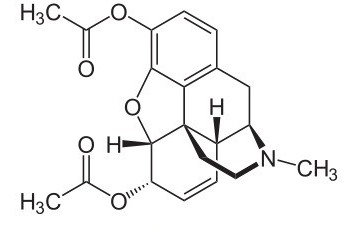Heroin (C21H23NO5) is a white, crystalline powder synthesized from morphine, a natural alkaloid extracted from the seedpod of the Asian opium poppy plant, Papaver somniferum. It is a powerful opioid drug prepared by the addition of two acetyl groups to the morphine molecule and is classified as a sedative and narcotic. Heroin is a highly addictive substance and causes the most serious problem in illicit opium usage. It can be injected intravenously, smoked, or sniffed (snorted). Any of these routes of administration delivers the drug to the brain, where it is then converted back into morphine, which binds to the brain's opioid receptors, that is, molecules on the surface of cells that mediate the cell structures that function as intermediaries between the opioid and the physiological response. Chronic use of heroin typically results in the development of tolerance for the substance (whereby increasing amounts of the drug are necessary to achieve the desired effect), physical dependence (characterized by a sequence of well-defined signs and physiological effects, including painful and unpleasant withdrawal symptoms upon discontinuance of the drug's use), and compulsive drug-seeking behavior (which often leads to injury to the drug user or others). In many cases, overdose may lead to serious, harmful symptoms or death. It has been determined that the prompt administration of the medication naloxone can reverse the effects of heroin overdoses. See also: Addiction and addictive disorders; Alkaloid; Brain; Incentive-sensitization disease model of addiction; Morphine alkaloids; Narcotic; Opiate; Poppy; Sedative

Heroin was initially synthesized in 1874, although it was not used for pharmaceutical purposes until the late 1890s. At that time, the German pharmaceutical company Bayer marketed heroin (the brand name assigned to the substance known chemically as diacetylmorphine) as a treatment for coughs, as a pain-relieving analgesic, and as a nonaddictive morphine substitute. In a remarkable twist, however, the drug was found to be more addictive than morphine, leading to the prohibition of its use around the globe. See also: Analgesic; Pain; Pharmaceutical chemistry; Pharmacology
The cultivation of the opium poppy plant, the extraction of morphine from the plant, and the processing of heroin occur predominantly in Southeast Asia, Southwest Asia, Mexico, and South America. Afghanistan is the main supplier of opium, accounting for more than three-fourths of the world's supply, whereas Mexico and Colombia are the primary suppliers of heroin to North America. The trafficking of heroin is a major concern of all drug enforcement agencies, but the continual demand for heroin prevents any true halt to its worldwide distribution and it continues to be sold illicitly, with often dire consequences to those addicted to it.





